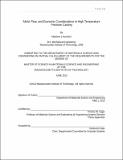| dc.contributor.advisor | Thomas W. Eagar. | en_US |
| dc.contributor.author | Humbert, Matthew S | en_US |
| dc.contributor.other | Massachusetts Institute of Technology. Department of Materials Science and Engineering. | en_US |
| dc.date.accessioned | 2013-11-18T17:35:20Z | |
| dc.date.available | 2013-11-18T17:35:20Z | |
| dc.date.copyright | 2013 | en_US |
| dc.date.issued | 2013 | en_US |
| dc.identifier.uri | http://hdl.handle.net/1721.1/82171 | |
| dc.description | Thesis (S.M.)--Massachusetts Institute of Technology, Dept. of Materials Science and Engineering, 2013. | en_US |
| dc.description | This electronic version was submitted by the student author. The certified thesis is available in the Institute Archives and Special Collections. | en_US |
| dc.description | Cataloged from student-submitted PDF version of thesis. | en_US |
| dc.description | Includes bibliographical references (p. 46-47). | en_US |
| dc.description.abstract | Casting high temperature alloys that solidify through a noticeable two phase region, specifically platinum-ruthenium alloys, is a particularly challenging task due to their high melting temperature and this necessitates careful design of the mold material and mold geometry to produce defect free castings. Here fluid flow, heat flow, and chemical interactions were investigated with simulations and casting experiments. Three mold recipes were developed; an improved magnesium-phosphate binder silica sand based system, a magnesium-aluminum phosphate binder alumina sand based system, and a colloidal zirconia sol binder zirconia sand based system. The fluid and heat flow analysis has shown, and has been verified by experiment, that using a mold material with a low heat diffusivity, (the product of thermal conductivity, heat capacity, and density) will improve casting quality by delaying solidification and reducing interdentritic porosity. A simple economic framework was developed to compare the price of different ceramics with the results showing that silica is a more economic mold material at an estimated 75% yield over a zirconia or alumina mold with a 100% yield. This framework neglected how secondary processing and efficiency gains affect cost. The likely implementation of this research will be a zirconia face coat supported in the flask by magnesium phosphate bonded silica. This will provide the required heat diffusivity and mechanical support at the lowest cost to minimize interdentric porosity. | en_US |
| dc.description.statementofresponsibility | by Matthew S. Humbert. | en_US |
| dc.format.extent | 70 p. | en_US |
| dc.language.iso | eng | en_US |
| dc.publisher | Massachusetts Institute of Technology | en_US |
| dc.rights | M.I.T. theses are protected by
copyright. They may be viewed from this source for any purpose, but
reproduction or distribution in any format is prohibited without written
permission. See provided URL for inquiries about permission. | en_US |
| dc.rights.uri | http://dspace.mit.edu/handle/1721.1/7582 | en_US |
| dc.subject | Materials Science and Engineering. | en_US |
| dc.title | Mold, flow, and economic considerations in high temperature precision casting | en_US |
| dc.type | Thesis | en_US |
| dc.description.degree | S.M. | en_US |
| dc.contributor.department | Massachusetts Institute of Technology. Department of Materials Science and Engineering | |
| dc.identifier.oclc | 861619229 | en_US |
